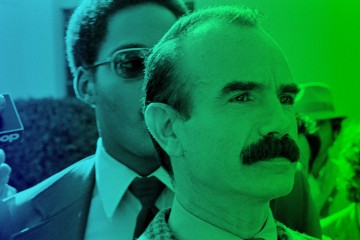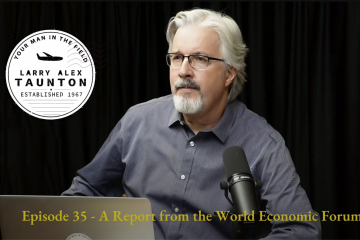In October 1944, as the war in the Pacific was moving into what we now know was its final phase, the outcome was anything but certain for the combatants. Imperial Japan was battered, but she remained lethal. The atomic bomb was still in development and the Japanese high command was preparing to unleash the “divine wind,” the kamikaze pilots, a desperate strategy that would inflict extraordinary carnage on their bitter American enemy.
Even so, American forces, in a steady, relentless, and bloody “island-hopping” campaign, were advancing across the Pacific lopping off one stronghold after another from the Japanese empire like a lumberjack paring limbs off a tree that he might lay an axe to the trunk. The next limb was the reconquest of the Philippines and the fulfillment of General Douglas MacArthur’s famous promise, “I shall return.”
On October 20, after a series of airstrikes on the landing zone, MacArthur and 130,000 men of the U.S. Sixth Army went ashore on Leyte, an island in the southern Philippine archipelago. Unlike so many other amphibious landings on Japanese-held islands, this one was surprisingly uncontested. Not a single Japanese soldier challenged the Americans as they waded through the surf. It was all part of a carefully prepared Japanese strategy called Sho-Go—“Operation Victory”—a plan whose central aim was to destroy U.S. forces on the beach before they could move inland.
To prevent this, Admiral Thomas C. Kinkaid’s Seventh Fleet would cover the southern approaches to Leyte at Surigao Strait while Admiral William “Bull” Halsey’s Third Fleet would cover the northern approaches at San Bernardino Strait. In the eventuality that Halsey pursued another target, he was expected to carve out of his massive fleet an independent fighting force under the command of Vice Admiral Willis “Ching” Lee. This group, designated Task Force 34, with a full complement of battleships and aircraft carriers, would be equal to any Japanese attempt to force entry into the San Bernardino Strait.
For their own part, the Japanese knew very well that they could not risk exchanging broadsides or airstrikes with Halsey’s leviathans. Their plan was much subtler: keep Kinkaid occupied in the Surigao Strait with their Southern Force; lure Halsey away from the San Bernardino Strait (and the beaches) with their Northern Force; and then send Center Force, the spearhead of their attack, through the Strait uncontested and destroy MacArthur’s army.
To accomplish this, the Japanese, having made a careful study of Halsey’s character, reckoned him unhappy in his role of babysitter to MacArthur’s Sixth Army and believed that he would, if given a chance, prefer to destroy an enemy fleet. On October 24, the Japanese dangled a carrot in the form of Admiral Ozawa’s ragtag Northern Force which, enticing to Halsey, included aircraft carriers, but, unknown to Halsey, aircraft carriers that were largely void of aircraft. With his spotter planes catching sight of Ozawa’s fleet as the Japanese intended they would, Halsey, eager for a fight, took the bait, abandoned the San Bernardino Strait, and pursued the decoy fleet northward taking Lee’s Task Force 34 with him. With the Strait unguarded, the door was wide open.
The Japanese plan had worked to perfection. At midnight on October 24, the main Japanese assault force under Admiral Takeo Kurita slid under cover of darkness into San Bernardino Strait from the west and prepared to pound MacArthur’s Sixth Army. Unprotected, the boys ashore faced certain annihilation. All that stood between them was “Taffy 3,” a flotilla under the command of Admiral Clifton “Ziggy” Sprague consisting of ships whose purpose was to provide support for ground troops. Nothing in Sprague’s command was suited to surface warfare against capital ships. Indeed, Kurita’s super-battleship, Yamato, the pride of Japan, was the largest and most modern battleship ever built up to that time, possessing a displacement tonnage greater than Taffy 3’s thirteen ships combined. Even her sister ship, the Musashi, which was also part of Kurita’s Center Force, was larger than anything in the United States Navy. Taffy 3 was more annoyance than threat.
With Halsey fighting in the north, Kinkaid in the south, and Sprague in the center, what followed was the largest naval battle in history, including more than 250 ships, 2,000 aircraft, 200,000 men, and encompassing roughly 100,000 square miles of open water. As Sprague’s “tin cans” readied to sacrifice themselves as, at best, a delaying measure to Kurita’s sleek pagoda-shaped monsters, he radioed Admiral Kinkaid asking for help from Lee’s Task Force 34. Kinkaid, himself preparing for battle, believed Task Force 34 still blocked San Bernardino Strait. Why was Sprague distressed? Where was Lee? Messages flew hot from Kinkaid to Halsey, which the latter promptly ignored.

Admiral Halsey from the National Portrait Gallery
Fifteen-hundred miles away at Guam, the messages were overheard by U.S. Pacific Fleet’s advance headquarters where they were relayed a further 3,800 miles, lighting up Admiral Chester Nimitz’s CINCPAC—Commander-in-Chief of Pacific Command—headquarters at Pearl Harbor. The first radio message came in the form of an uncharacteristically unencrypted plea:
ENEMY FORCES ATTACKING OUR FORCES …. REQUEST LEE PROCEED TOP SPEED COVER LEYTE. REQUEST IMMEDIATE STRIKE BY FAST CARRIERS.
This was met with confusion at Pearl. Wasn’t Task Force 34 covering San Bernardino Strait?
“NEGATIVE” came the reply.
Halsey, far to the north, having by now unleashed the full fury of Third Fleet on Ozawa’s largely planeless aircraft carriers, wasn’t responding. But the messages, each taking two hours to reach their destination, kept coming, becoming increasingly desperate as the morning wore on:
FAST BATTLESHIPS URGENTLY NEEDED IMMEDIATELY AT LEYTE.
Like the Spartans at Thermopylae, Sprague’s ships fought with a ferocity that the Japanese admired. But they were vastly outmatched. Kurita’s 18-, 16-, and 14-inch guns—Taffy 3 had none bigger than 5-inch—did their bloody work. “The Johnston was a mess,” wrote one sailor. “There were dead men on the deck and gaping holes …” Such was the case with most of Taffy 3. Another said the decks of ships, bespattered with body parts, appeared to be covered with spaghetti.
Still, they fought on. One captain, his bridge blown apart, stood stripped to the waist, bleeding, shrapnel in his neck and fingers missing, refused to withdraw, willing his ship to press the attack. “I can see him now,” wrote one eyewitness after the war. “As he went by on our starboard side, he turned a little and waved. That’s the last I saw of him.”
Another message from Kinkaid, the last, begged Halsey to act:
MY SITUATION IS CRITICAL. FAST BATTLESHIPS AND SUPPORT FROM AIR STRIKE MIGHT BE ABLE TO PREVENT ENEMY FROM ENTERING LEYTE.
Back at Pearl, Nimitz could stand it no longer. Mystified by Halsey’s apparent failure to respond to Kinkaid’s repeated calls for help and alarmed by the impending disaster at Leyte, the Commander-in-Chief of the Pacific Fleet decided it was time that he sent his own message to the missing admiral. What Halsey received was this now-famous straightforward reprimand:
WHERE, REPEAT, WHERE IS TASK FORCE 34? THE WORLD WONDERS.
Halsey, recognizing the irritation of his commanding officer, ordered Lee to pull out of the line-of-battle and turn 180 degrees to the south. But it was a pointless maneuver. Along with the rest of Third Fleet, Task Force 34 was now 200 miles from Leyte Gulf and would be too late to offer any meaningful support to Taffy 3.
* * * * *
Admiral Halsey’s actions at the Battle of Leyte Gulf—and those of Admiral Kurita—would become one the great post-war debates. As it turned out, Taffy 3’s sacrifice was not in vain. Having laid down a smoke screen at the beginning of the battle, the Japanese remained confused throughout the morning about the size and nature of the enemy confronting them. As a consequence, Kurita, fearing they were the advance element of a much larger force, withdrew.
A few days later, Nimitz reflected on the astonishing outcome of the battle in a private letter to Admiral Ernest J. King:
It never occurred to me that Halsey … would leave the San Bernardino Strait unguarded … That the San Bernardino detachment of the Japanese Fleet, which included the Yamato and the Musashi, did not completely destroy all of [Taffy 3] and their accompanying screen is nothing short of special dispensation from the Lord Almighty.
It is instructive to me that in the greatest naval battle in history, the biggest, most heavily armed ships in the United States Navy never fired a shot. Moreover, the bulk of the U.S. Naval Forces in this theater were engaged in the wrong battle at the wrong time. Lee’s Task Force 34, more than a match for the elements of Kurita’s armada, played no role in the battle whatsoever, that being decided by a much smaller, poorly equipped flotilla that most certainly would have been annihilated had Kurita stayed the course, to say nothing of the inevitable destruction of MacArthur’s Sixth Army.
The American church, like Halsey’s Third Fleet, is a leviathan. But sometimes I feel as though my articles are like Kinkaid’s shrill pleas for help. The church is engaged, but seldom in the right battle at the right time, and I fear she will go down without ever bringing her considerable weight to bear in the cultural war.
What our country sorely needs in this moment of our history are men of courage. It needs a church that is confident in the strength of the Lord and preaches and teaches unashamedly not just truth, but truth that reinforces the line where the battle rages.
Halsey was fighting, but not where the enemy was concentrating his forces. When was the last time your pastor addressed transgenderism, critical race theory, politically motivated violence, rioting, freedom, private property, theft, self-responsibility, Marxism, or our unity in Jesus Christ? It’s not as if the Bible doesn’t have anything to say about these things—it does—but very few pastors are mining them. Worse, many who do preach on these issues do so from the “woke” perspective rather than from the biblical one.
An old seminary professor of mine used to say that if in your preaching you cannot demonstrate the relevance of the text to where the battle is being waged, “you get an F.” It’s not enough to say that Jesus could turn water into wine or that David wrote beautiful psalms or that Daniel survived a lion’s den. You must answer the “So what?” question.
In closing, let me add that I might have abbreviated the story of this extraordinary battle. Perhaps you would prefer that I had done so. But that would have been a great injustice to the men who fought and died in it. The details matter, and those men deserve to be remembered. The recollection of their sacrifice should move you. Would you so casually give away what they bequeathed to you?
The enemy is slipping through a spiritual equivalent of the San Bernardino Strait, and people are desperately seeking to plug the gap. Unfortunately, too often they find little in their churches to help them do it.
WHERE, REPEAT, WHERE IS TASK FORCE 34? THE WORLD WONDERS.
Larry Alex Taunton is the Executive Director of the Fixed Point Foundation and a freelance columnist contributing to USA Today, Fox News, First Things, The Atlantic, CNN, Daily Caller, and The American Spectator. He is also the author of The Grace Effect, The Gospel Coalition Book of the Year The Faith of Christopher Hitchens, Around the World in (More Than) 80 Days. (Available to order now) You can subscribe to his blog at refined-badger-e0ceb8.instawp.xyz and find him on Twitter @larrytaunton.
WAIT!
Do you appreciate the content of this website?
We are a nonprofit. That means that our work is made possible and our staff is paid by your contributions. We ask you to consider supporting this important work in an ongoing basis or, if you prefer, perhaps you will drop a few bucks in our “tip jar.”
All contributions are tax-deductible

